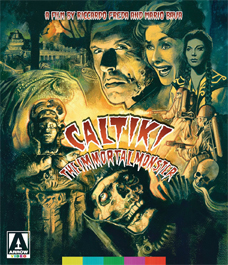 CALTIKI,
THE IMMORTAL MONSTER (1959) Blu-ray/DVD combo
CALTIKI,
THE IMMORTAL MONSTER (1959) Blu-ray/DVD comboDirector(s): Riccardo Freda (as Robert Hampton) and Mario Bava (uncredited)
Arrow Video USA
 CALTIKI,
THE IMMORTAL MONSTER (1959) Blu-ray/DVD combo
CALTIKI,
THE IMMORTAL MONSTER (1959) Blu-ray/DVD comboMario Bava gets nudged into the director's chair in Arrow Video USA's Blu-ray/DVD combo of the early Italian sci-fi pic CALTIKI, THE IMMORTAL MONSTER.
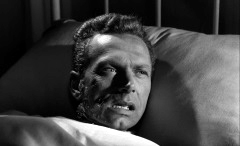
When archaeologist Nieto (Arturo Dominici, BLACK SUNDAY) comes stumbling into the expedition camp in a delirium, the other expedition members – biologist John Fielding (John Merivale, THE LIST OF ADRIAN MESSENGER), cameraman Bob (Daniele Vargas, CEMETERY WITHOUT CROSSES), and treasure hunter Max (Gérard Herter, THE BIG GUNDOWN) – go looking for missing colleague Ulmer in the nearby Mayan ruins and discover a chamber within a recently erupted volcano that turns out to be the shrine of the goddess Caltiki. There is no sign of Ulmer, but footage from his abandoned camera reveals an attack on the two men by persons unknown. Leaving Nieto in the care of John's prissy wife Ellen (Didi Sullivan) and Max's "halfbreed" girlfriend Linda (Daniela Rocca, DIVORCE ITALIAN STYLE), the men return to the cave and Bob discovers the bejeweled remains of Caltiki's sacrificial offerings in the lake surrounding her shrine. The stone idol of Caltiki turns out not to be that much of a likeness when the titular creature emerges from the water as a slimy amorphous blob whose secretions eat away at Max's arm when he tries to make off with some of the jewels Bob has recovered from underwater. John saves the day by piloting a gasoline truck into the cave but Max loses his arm and an infection spreads to the rest of his body and into his bloodstream. Working from a samples of the creature taken off Max's arm, they discover that the creature is a twenty-million-year-old single-celled organism that may indeed be the mythical Caltiki who is prophesized to destroy the world when she reunites with her mate in the sky. As a comet that has not been seen from the Earth since 607 A.D. (when the Mayans disappeared from the expedition site) nears the planet once again, the fragment of Caltiki starts to grow exponentially and wreak havoc on Mexico City.
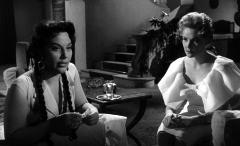 A
rare early example of Italian science fiction – a genre later embraced
by Antonio Margheriti (THE WILD WILD PLANET), Luigi Cozzi (STARCRASH), and Alfonso
Brescia (THE BEAST IN SPACE) – CALTIKI, THE IMMORTAL MONSTER draws from
British examples like THE QUATERMASS EXPERIMENT and X-THE UNKNOWN and American
ones like THE BLOB to lesser effect. Much of the film is a wonderful showcase
for the glass mattes, back projection, and other in-camera tricks of uncredited
co-director Mario Bava (BLACK SABBATH) while the expository scientific and dramatic
scenes were handled by Riccardo Freda (THE HORRIBLE DR. HICHCOCK) in a manner
that manages to be simultaneously overwrought (especially in the English dub)
and apathetic. The middle section drags as it seems that Max – embittered
by his disfigurement and maddened with greed for the gold, and resenting John
for having Ellen who rejected him – will either transform into Caltiki
or serve the goddess, but he ends up posing a more human threat during the climax
in which the creature expands and pulls down Fielding's Mexican villa around
it. The monster is laughable but there are a couple grisly bits like the remains
of Max's arm once the fragment of Caltiki is removed from it and one character's
skin rotting consumption by the monster during the climax. Although it never
convinces as an American or British genre effort, CALTIKI at times does look
less Italian and somewhat more like a Mexican horror film due to the studio-bound
exteriors and interiors. Giacomo Rossi Stuart (KILL BABY KILL) appears as one
of the scientists who submit the fragment of Caltiki to radiological testing.
A
rare early example of Italian science fiction – a genre later embraced
by Antonio Margheriti (THE WILD WILD PLANET), Luigi Cozzi (STARCRASH), and Alfonso
Brescia (THE BEAST IN SPACE) – CALTIKI, THE IMMORTAL MONSTER draws from
British examples like THE QUATERMASS EXPERIMENT and X-THE UNKNOWN and American
ones like THE BLOB to lesser effect. Much of the film is a wonderful showcase
for the glass mattes, back projection, and other in-camera tricks of uncredited
co-director Mario Bava (BLACK SABBATH) while the expository scientific and dramatic
scenes were handled by Riccardo Freda (THE HORRIBLE DR. HICHCOCK) in a manner
that manages to be simultaneously overwrought (especially in the English dub)
and apathetic. The middle section drags as it seems that Max – embittered
by his disfigurement and maddened with greed for the gold, and resenting John
for having Ellen who rejected him – will either transform into Caltiki
or serve the goddess, but he ends up posing a more human threat during the climax
in which the creature expands and pulls down Fielding's Mexican villa around
it. The monster is laughable but there are a couple grisly bits like the remains
of Max's arm once the fragment of Caltiki is removed from it and one character's
skin rotting consumption by the monster during the climax. Although it never
convinces as an American or British genre effort, CALTIKI at times does look
less Italian and somewhat more like a Mexican horror film due to the studio-bound
exteriors and interiors. Giacomo Rossi Stuart (KILL BABY KILL) appears as one
of the scientists who submit the fragment of Caltiki to radiological testing.
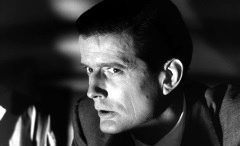
Released theatrically through Allied Artists, CALTIKI gained much of its American audience through the company's television version which padded the timeslot by recycling some of the "native" dance sequence footage (although it was apparently the theatrical cut that ended up available on the grey market through companies like Sinister Cinema). The first legitimate release of the film on DVD was in Italy through NoShame in an anamorphic widescreen transfer with English and Italian audio tracks and a handful of Italian-only extras (see below). When NoShame went out of business, Luigi Cozzi's Sinister Film label reissued it without the extras using the same master which was incorrectly flagged for 4:3, playing the pillarboxed widescreen transfer squeezed to 1.33:1 (although this could easily be rescaled on most software players and televisions/players that played back 4:3 material stretched to 16:9).
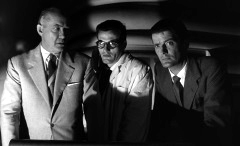 The
1080p24 MPEG-4 AVC 1.66:1 pillarboxed widescreen transfer on Arrow Video's dual-territory
Blu-ray/DVD combo is the best the film has looked but still a mixed blessing.
The enhanced resolution allows greater appraisal of Bava's special effects while
also exposing more of their artifice than intended like the very obvious cyclorama
behind the jungle scenes, Dominici's shadow on the screen on which the background
is projected as he crosses from artificial background to a real set in one panning
camera movement, and the flatness of some of the magazine clippings Bava pasted
to the glass mattes meant to give a bit of depth to the composition (Caltiki
itself now looks more like a slimy sleeping bag). The image is still dark but
the commentators suggest that Bava had it printed dark to obscure the matte
lines. Although not as handsomely lensed as some of Bava's subsequent black
and white horror and giallo efforts, CALTIKI's new transfer does restore a degree
of gloss missing from the Allied Artist-sourced boots. Audio options include
the English dub (directed by Lee Kresel who also directed the AIP redub of BLACK
SUNDAY) in LPCM 1.0 mono, a composite from a variety of less-than-optimal sources
(the menu actually recommends auditing the Italian track with subtitles) or
Italian LPCM 1.0 with English SDH subtitles for the English track and English
subtitles for the Italian. While examining the camera negative, it was discovered
that some of the film was shot with a hard matte for 1.66:1 but much of it including
Bava's effects shots were filmed without one (Bava's shot his later films with
a hard-matte for the effects shots). The alternate full aperture version in
the extras menu is shown in its entirety in Italian LPCM 1.0 with English subtitles
from the same master as the feature encode.
The
1080p24 MPEG-4 AVC 1.66:1 pillarboxed widescreen transfer on Arrow Video's dual-territory
Blu-ray/DVD combo is the best the film has looked but still a mixed blessing.
The enhanced resolution allows greater appraisal of Bava's special effects while
also exposing more of their artifice than intended like the very obvious cyclorama
behind the jungle scenes, Dominici's shadow on the screen on which the background
is projected as he crosses from artificial background to a real set in one panning
camera movement, and the flatness of some of the magazine clippings Bava pasted
to the glass mattes meant to give a bit of depth to the composition (Caltiki
itself now looks more like a slimy sleeping bag). The image is still dark but
the commentators suggest that Bava had it printed dark to obscure the matte
lines. Although not as handsomely lensed as some of Bava's subsequent black
and white horror and giallo efforts, CALTIKI's new transfer does restore a degree
of gloss missing from the Allied Artist-sourced boots. Audio options include
the English dub (directed by Lee Kresel who also directed the AIP redub of BLACK
SUNDAY) in LPCM 1.0 mono, a composite from a variety of less-than-optimal sources
(the menu actually recommends auditing the Italian track with subtitles) or
Italian LPCM 1.0 with English SDH subtitles for the English track and English
subtitles for the Italian. While examining the camera negative, it was discovered
that some of the film was shot with a hard matte for 1.66:1 but much of it including
Bava's effects shots were filmed without one (Bava's shot his later films with
a hard-matte for the effects shots). The alternate full aperture version in
the extras menu is shown in its entirety in Italian LPCM 1.0 with English subtitles
from the same master as the feature encode.
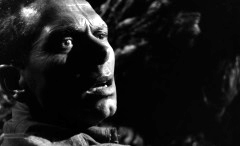
The film is also accompanied by two commentary tracks by two Bava book authors: Video Watchdog's Tim Lucas (MARIO BAVA: ALL THE COLORS OF THE DARK) and Troy Howarth (THE HAUNTED WORLDS OF MARIO BAVA). There is quite a bit of overlap between the two tracks, so they are better enjoyed separately with some space between rather than successively. Both discuss Freda's and Bava's previous collaboration on I VAMPIRI which Freda abandoned and Bava rewrote to complete in two days, Bava's actual directorial debut in THE DAY THE SKY EXPLODED (credited to Paolo Heusch), Freda's plan to intentionally leave CALTIKI after shooting the scenes with the actors and leaving the roughly one hundred effects shots to Bava as a means of easing him into the director's chair and showing producers Bava's capabilities, images and themes that anticipate Bava's later films (particularly BLACK SUNDAY and PLANET OF THE VAMPIRES), as well as the film's debt to Hammer's sci-fi efforts and reference to Edgar G. Ulmer. Lucas describes the how-tos of the effects shots in detail and relates anecdotes from Bava collaborators that sheds light on the just how much of Pietro Francisci's HERCULES he actually directed (Francisci reportedly napped on set most of the time and only directed when the press was around), as well as the film's post-production (at AIP dubbing studio Titra) and television padding. Howarth frames the rough edges of the effects as being an embracing of artifice in direct opposition to Italy's neorealist tradition, reveals that Freda had found financial security at the time in horse breeding and treated filmmaking as a hobby, as well as relating some of the contradictions in Freda's vaunting of Bava's talents including the idea that he believed he was doing Bava a favor when he was on the censor board by refusing FOUR TIMES THAT NIGHT as a lesser effort. Critic Kim Newman also offers up his take on the film in "From Quatermass to Caltiki" (18:13) in which he also contextualizes CALTIKI in terms of post-war American and British science fiction efforts – particularly Edgar G. Ulmer's MAN FROM PLANET X with its fusion of fifties genre trends with the Universal-era expressionist shadows, mist, gloom, and superstitious peasants – but seems unaware that Italian sci-fi precursor THE DAY THE SKY EXPLODED was indeed directed by Bava.
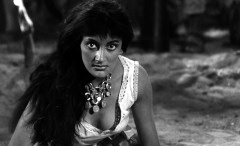 Ported
over from the NoShame DVD is an optional introduction (0:20) and featurette
"Riccardo Freda, Forgotten Master" (19:05) by Italian critic Stefano
Della Casa who discusses Freda's popularity with French before the new breed
of Italian criticism that no longer looked down upon anything that was not neo-realism,
becoming familiar with Freda through fellow critics who arranged a retrospective
in the 1980s, meeting the director when he was on film festival panels, and
his later years marked by his final credit as assistant director on Bertrand
Tavernier's REVENGE OF THE MUSKETEERS and the sad circumstances of his death.
Cozzi appears in "The Genesis of Caltiki" (21:32) in which he gives
some background on the production personnel, and makes the case that screenwriter
Filippo Sanjust (THE GOLDEN ARROW) deserves just as much credit as Freda and
Bava for the film and its influence since Sanjust also designed the sets for
the films he wrote (including this one) and would move on to become an opera
director and designer of international acclaim. The US theatrical trailer (2:07)
– which also demonstrates a lack of consensus in the pronunciation of
"Caltiki" – and cropped US Opening Titles (2:27) are also included
upscaled from SD. Not supplied for review were the reversible sleeve featuring
original and newly commissioned artwork by Graham Humphreys, and the illustrated
collector’s booklet featuring new writing by Diabolique Magazine's
Kat Ellinger and Roberto Curti (ITALIAN GOTHIC HORROR FILMS, 1957-1969) included
with the first pressing only. (Eric Cotenas)
Ported
over from the NoShame DVD is an optional introduction (0:20) and featurette
"Riccardo Freda, Forgotten Master" (19:05) by Italian critic Stefano
Della Casa who discusses Freda's popularity with French before the new breed
of Italian criticism that no longer looked down upon anything that was not neo-realism,
becoming familiar with Freda through fellow critics who arranged a retrospective
in the 1980s, meeting the director when he was on film festival panels, and
his later years marked by his final credit as assistant director on Bertrand
Tavernier's REVENGE OF THE MUSKETEERS and the sad circumstances of his death.
Cozzi appears in "The Genesis of Caltiki" (21:32) in which he gives
some background on the production personnel, and makes the case that screenwriter
Filippo Sanjust (THE GOLDEN ARROW) deserves just as much credit as Freda and
Bava for the film and its influence since Sanjust also designed the sets for
the films he wrote (including this one) and would move on to become an opera
director and designer of international acclaim. The US theatrical trailer (2:07)
– which also demonstrates a lack of consensus in the pronunciation of
"Caltiki" – and cropped US Opening Titles (2:27) are also included
upscaled from SD. Not supplied for review were the reversible sleeve featuring
original and newly commissioned artwork by Graham Humphreys, and the illustrated
collector’s booklet featuring new writing by Diabolique Magazine's
Kat Ellinger and Roberto Curti (ITALIAN GOTHIC HORROR FILMS, 1957-1969) included
with the first pressing only. (Eric Cotenas)